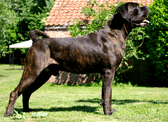Cane Corso
The Cane Corso (pronounced [ˈkaːne ˈkɔrso]) is an Italian breed of mastiff. It is used for personal protection, tracking, law enforcement, as a guard dog, and as a companion dog.[2]
| Cane Corso | |||||||||||||||||
|---|---|---|---|---|---|---|---|---|---|---|---|---|---|---|---|---|---|
.jpg) | |||||||||||||||||
| Other names |
| ||||||||||||||||
| Origin | Italy | ||||||||||||||||
| |||||||||||||||||
| |||||||||||||||||
| Dog (domestic dog) | |||||||||||||||||
History
According to the breed standard of the Fédération Cynologique Internationale, the Cane Corso descends from the molossoid dogs of Ancient Rome; it was once distributed throughout much of the Italian peninsula, but in the recent past was found only in Puglia, in southern Italy.[1][3] After the collapse of the mezzadria system of share-cropping in the 1960s, the dogs became rare. The modern breed derives from selective breeding from about 1980 of a few surviving animals.[4] A breed society, the Società Amatori Cane Corso, was formed in 1983.[5]:107[6] The breed was recognised by the Ente Nazionale della Cinofilia Italiana in 1994;[4] it was provisionally accepted by the Fédération Cynologique Internationale in 1996, and received full acceptance in 2007.[7] It was recognised by the American Kennel Club of the United States in 2010.[8]
Characteristics
The Cane Corso is a large dog of molossoid type, and is closely related to the Neapolitan Mastiff. In name and form the Cane Corso predates its cousin the Neapolitan Mastiff. It is well muscled[8] and less bulky than most other Mastiff breeds. The breed is known as a true and quite possibly the last of the coursing Mastiffs. The official Fédération Cynologique Internationale (FCI) standard expects ideal dogs to stand 58–70 cm (23–28 in) at the withers, with females in the lower range (58–66 cm (23–26 in)) and males in the higher (62–70 cm (24–28 in)). Weight should be in keeping with the size and stature of these dogs, ranging from 45–50 kilograms (99–110 lb) for males and from 40–45 kilograms (88–99 lb) for females.[1]
The head of the Cane Corso is arguably its most important feature. It is large and imposing. The forehead should be flat and convergent to the muzzle. The muzzle is flat, rectangular (when viewed from above), and generally as wide as it is long; approximately 33% the total length of the skull (a ratio of 2:1). The eyes are almond in shape, set straight and when viewed from the front, set slightly above the line of the muzzle. Darker eyes are preferred, however, the color of the eyes tends to emulate the shade of brindling in the coat.[3]
Cane Corso appear in two basic coat colours: black and fawn. This is further modified by genetic pigment dilution to create "blue" (grey, from black) and fromentino (from fawn, where the mask is blue/grey) colours. Brindling of varying intensity is common on both basic coat colours as well, creating Tigrato (black brindle), and Grigio Tigrato (blue brindle). White markings are common on the chest, tips of toes, the chin, and the bridge of the nose.
A 2017 study of 232 Cane Corso dogs across 25 countries found an average life span of 9.3 years, varying with different coat colours. The longest living were black brindle dogs (10.3 years) followed by brindle dogs (10.1 years), grey brindle dogs (9.8 years), fawn dogs (9.0 years), black dogs (9.0 years), grey dogs (9.0 years) and other colour dogs (8.1 years).[9]
These dogs are docile and affectionate to their owners, loving with children and family, and easily trained. They are an unequalled protector of the owners and their property.[10]
 With ears uncropped
With ears uncropped Blue coat, ears cropped
Blue coat, ears cropped Brown/brindle coat, ears and tail uncut
Brown/brindle coat, ears and tail uncut- Fromentino puppy
References
- "FCI Standard 343" (PDF). FCI. Retrieved 17 October 2014.
- "Breed Standards : Cane Corso Italiano - United Kennel Club (UKC)". www.ukcdogs.com. Retrieved 4 February 2019.
- Cane Corso Standard Archived 11 January 2009 at the Wayback Machine of Ente Nazionale della Cinofilia Italiana
- S.P. Marelli, A. Monaghé, M. Polli, L. Guidobono Cavalchini (2003). Body measurements and morphological evaluation of Italian Cane Corso. Italian Journal of Animal Science 2 (supplement): 88–90. doi:10.4081/ijas.2003.11675924. (subscription required).
- Rino Falappi (2009). Cani: Conoscere, riconoscere e allevare tutte le razze canine più note del mondo (in Italian). Novara: Istituto Geografico De Agostini. ISBN 9788841854068.
- Home (in Italian). Società Amatori Cane Corso. Accessed July 2020.
- FCI breeds nomenclature: Cane Corso Italiano (343). Fédération Cynologique Internationale. Accessed July 2020.
- Get to Know the Cane Corso. The American Kennel Club. Accessed July 2020.
- Korec, Evžen (2017), "Longevity of Cane Corso Italiano dog breed and its relationship with hair colour" (PDF), Open Veterinary Journal, 7 (2): 170–173
- "AKC Official Standard of the Cane Corso" (PDF). Retrieved 4 February 2019.